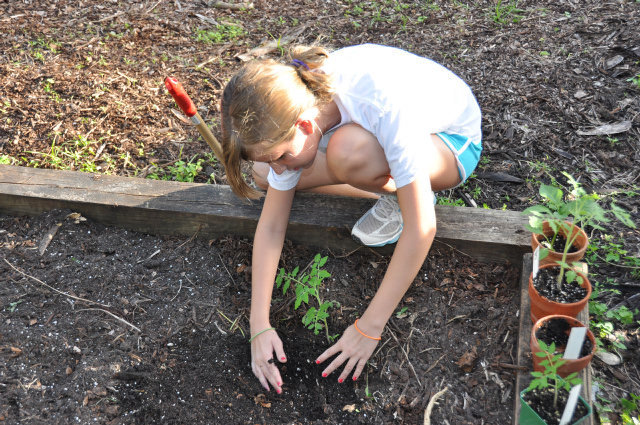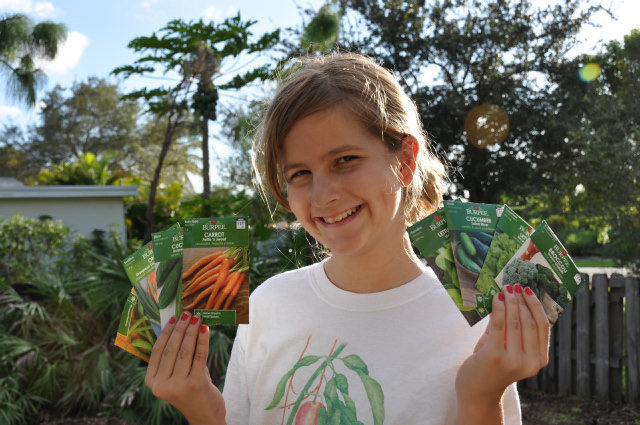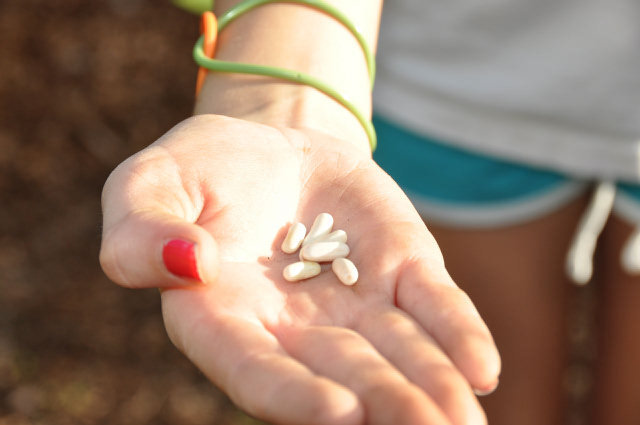Edible gardens promise more than vegetables

As published in The Miami Herald
At a time when my tween daughter is fully entrenched in texting and technology, some very strange words have been falling out of her mouth. “Dad, you promised we would have cucumbers this year, right?” “Dad, you are going to build that second vegetable garden bed like you said, aren’t you?” “I don’t think we planted enough carrots last year.”
She has been peppering me with these comments and questions for the last two months because she knows it is almost time to plant our edible garden. What could possibly tear a tween away from the internet and all the ‘LOLs’ a smartphone brings each day? It is the draw of growing her own vegetables and it has captivated her ever since she planted those first cherry tomatoes when she was only five.
 |
| Make sure you plant your seeds at the right depth. |
If you have never planted a vegetable garden, now is the perfect time to start. And by involving the whole family you will gain more than just a bountiful garden, you will gain knowledge, togetherness and a true sense of accomplishment for your little ones. My daughter has told me many times that she will simply not eat tomatoes from the grocery store as they have no flavor whatsoever, yet she picks and gobbles tomatoes from our garden each day after school as though they were ice cream covered in chocolate.
As the final rains of October fall and the nighttime temperatures begin to dip below 70 degrees, the season is right for planting vegetables. While the rest of the country prepares for freezing temperatures and a bitter winter, South Florida’s climate becomes just right for growing. Early November is the best time to plant, but you can get started preparing your garden now.
A vegetable garden in South Florida needs to be planted in a raised bed, as our calcareous native soil is rocky and has a high pH. Make your bed about four feet wide so you can reach the center from either side and then you can make it as long as you like. If this is your first year making a garden, an eight foot by four foot bed should be just right.
You want to create a border for your bed that is at least 18 inches deep to hold in the soil. The border can be made of cinder blocks, brick, stone, plastic or non-pressure treated wood. Fill the bed with soil that is rich in organic material and drains well. If money is not an object, you can use some of the pre-mixed potting soils found in the home improvement stores. Just make sure they contain Perlite as this is essential to help with drainage. A cheaper option is to use some soils that are not pre-mixed. Just make sure that you do add Perlite to them to help with drainage.
 |
| Samantha Wasielewski shows off her choice for this year’s garden. |
Over time, you can augment your soil with compost. Composting is easy to do in South Florida and you can make your own composting bin with just some wire mesh and zip ties. You can find out how to make your own composting bin on Fairchild’s YouTube channel at www.youtube.com/fairchildgarden.
Once you create your bed, you can start to think about planting. It’s a good idea to make a list of what you want and then to map the garden as to how you will plant it. Many of the things you will plant will be from seed and if you don’t map it out, you won’t know what is what when they start to germinate.
You can plant seeds of lettuce, carrots, cucumbers, spinach, bush beans (preferred over pole beans) and squash directly into your garden. Other crops such as tomatoes, broccoli, cabbage, eggplant and peppers should go into your garden as seedlings. Herbs such as basil, oregano, mint, rosemary, cilantro, catnip, lavender and sage should also be planted as seedlings.
Seeds will come in all different shapes and sizes and each one should be planted differently. Tiny seeds like carrots can be sprinkled on top of the soil and then dusted with soil while larger seeds like the bush beans should be planted just below the surface of the soil. If you are planting seedlings, then make sure they get planted at the proper depth—not too deep so that the stem is buried or too high where their roots are exposed.
Once the garden is planted, use a hose to water everything in. Be careful not to water too heavily as intense sprays of water can move your seeds from place to place.
Watering should take place each day after the garden is planted. Watering in the morning is best as the garden will have time to dry its leaves before nightfall. Water so the garden is moist but not soaking wet.
You should begin to see germination in just a few days on some of the seeds. Use your map to see what is what. Be on the look out for weed seeds germinating along side of your vegetables and remove them promptly.
 |
| Seeds come in many different shapes and sizes. These bush bean seeds are large and should by planted just below the surface of the soil. |
Your garden will take several weeks to begin to produce and you will delight in seeing your stalks of broccoli and tiny tomatoes begin to appear.
Whether you plant your garden on your own or with your kids, it will be a fun and rewarding experience. I promise you, you will never have a better or more delicious tomato, cucumber or salad, then what you get from your very own garden.
My daughter and I look forward to planting our edible garden each year. Why not make this year the year you finally start your own?
For more information on planting your own garden, visit Fairchild’s Edible Garden Festival October 20 and 21.
